The DocLab Interactive Conference closed at De Brakke Grond in Amsterdam on Sunday 19th of November. An integral part of the International Documentary Film Festival Amsterdam (IDFA), DocLab looks at how contemporary artists, designers, filmmakers and other creators use technology to devise and pioneer new forms of documentary storytelling. There’s an exhibition, an immersive network summit, screenings, performances and a conference. The conference is my favourite. Digital pioneers share with the audience their latest experiments and boldest visions of the future. Each year, the same thing happens: the talks start at 10 in the morning, i blink and it’s already 6pm. Their picnic bag is a monstrosity for anyone who’s into eating healthy (more about food later) but that’s just about the only negative thing i can say about the event.
Here are the notes i wrote down during the talks. They are not exhaustive, they only aim to highlight a few ideas and projects i found particularly thought-provoking:
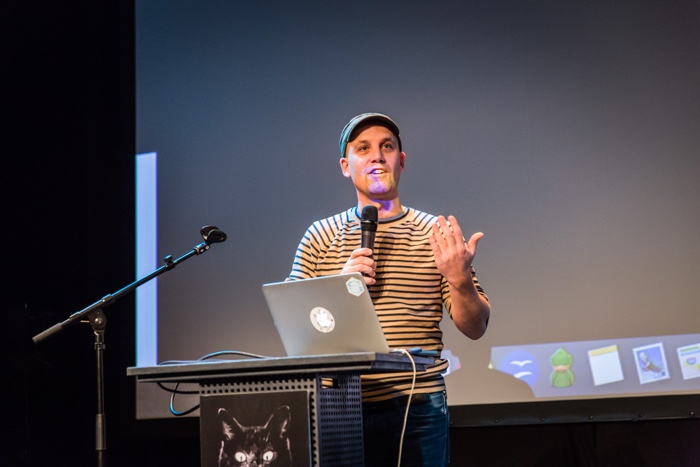
Brett Gaylor at Doclab interactive conference in de Brakke Grond, part of the IDFA. Photo Nichon Glerum
Superflux and Mozilla, Our Friends Electric
Brett Gaylor is the project lead for Mozilla’s Web Made Movies project. Before working with Mozilla, Brett directed the award wining documentary Rip! A Remix Manifesto (2008), an open source documentary investigating remix culture and copyright in the digital age. Two years ago, he authored Do not Track: an online, interactive documentary series about who’s watching you and who’s profiting from your private data.
In his brief and lively presentation, Gaylor talked about the Internet of Shit and the connected salt shakers, forks and other ‘smart objects’ that are actually stupid, insecure and easily hackable. He also showed us an extract of Our Friends Electric, a short film by Superflux and Mozilla which imagines life in the company of an AI virtual assistant that has its own personality.
But if there’s one link you should click on in this pre-Christmas silly period, it’s this one: privacy not included, a guide for shopping connected gadgets that respect your online privacy and security.

Memo Akten at Doclab interactive conference in de Brakke Grond, part of the IDFA. Photo Nichon Glerum
Human Nature – Supernormal Stimuli
Memo Akten is a computational artist interested in tools that enable people to express themselves. His work also looks at the tensions between nature, science, technology, ethics, ritual, tradition and religion.
Akten will i’m sure go down in media art history as a brilliant researcher into AI but also as the guy who told us about Australian beetles mating habits. The males of the Julodimorpha bakewelli species like to couple with big, brown-orangey conquests covered in dimples. Which leads them to copulate with discarded brown beer bottles. The behaviour nearly wiped out the whole species until the beer company decided to change the bottle design and save them from extinction.
Humans are not necessarily always more perceptive than beetles. We also project meaning into what we see and Akten’s work explores how this translates when it comes to algorithms and how the way we use AI actually uncovers our own human biases.
He also made a couple of valid points about the rise of AI and the explosion of big data. The artist believes that AI has been around for years but we need it now more than before to make sense of big data. A second reason for this new interest in AI is that the very organizations that push it are the ones that rely the most on big data to make profits.

Bogomir Doringer at Doclab interactive conference in de Brakke Grond, part of the IDFA. Photo Nichon Glerum
Short documentary which sums up the concept and background of FACELESS
The stand-out talk for me was Bogomir Doringer‘s. The artist and curator contemporary investigates collective and individual dynamics. He introduced us to two of his ongoing areas of research.
The first one is FACELESS which started in 2005, turned into an exhibition at q21 MuseumsQuartier Vienna in 2012 and has now taken the form of a book that should be published next year. FACELESS looks at the topic of hidden faces in society in relationship to the surveillance technologies deployed by government after 9/11. He showed us dozens of examples that demonstrate how widespread hidden and masked faces have become in the media, in the creative arts and in pop culture. From David Bowie album cover to Raf Simons putting balaclavas on the runway in 2012. From Adam Harvey to public protests where people wear masks to express that they are one body. From Burqa fetish to Jill Magid’s performance with CCTV in Liverpool.
The second research Doringer presented is I Dance Alone, a work in progress anchored in the artist’s experience of partying in the club Industria in Belgrade during the 1999 Nato bombings. To mock death or simply to try and forget about it. I Dance Alone places cameras above and on the dance floor in order to understand the rituals taking place when people dance. One of these rituals has urgency. The other is all about entertainment. I found the ‘urgency’ side of the research fascinating. Aside from the Industria nightclub, the artist also mentioned Bassiani, a nightclub in Tbilisi, Georgia. One important dimension of Bassiani is its social activism and in particular the way it encourages clubbers to join street protests, influence drug policy and tolerance towards the LGBTQ community in the country.
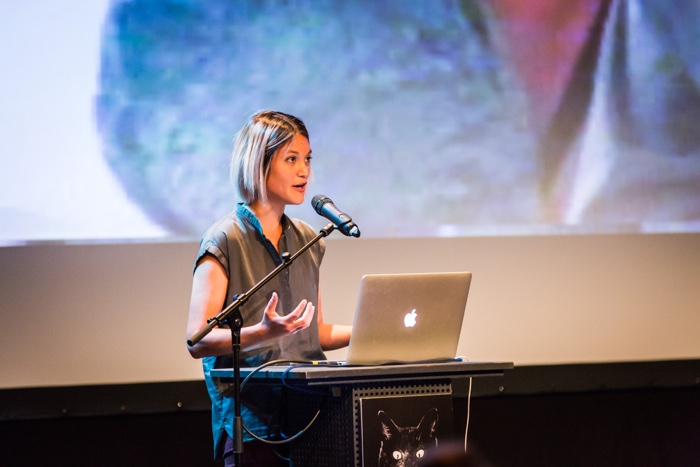
Lauren McCarthy at Doclab interactive conference in de Brakke Grond, part of the IDFA. Photo Nichon Glerum

Lauren McCarthy performance as part of Doclab. Photo Nichon Glerum
Lauren McCarthy discussed her attempts to become a human version of Alexa. The performance involves having access to all the software that runs your house and installing all kinds of gadgets in your home. Once everything’s in place you can ask her anything. From the weather forecast to an honest opinion about your new outfit.

Conference host Ove Rishøj Jensen introducing Jonathan Harris at Doclab interactive conference in de Brakke Grond, part of the IDFA. Photo Nichon Glerum

Jonathan Harris at Doclab interactive conference in de Brakke Grond, part of the IDFA. Photo Nichon Glerum
This edition of IDFA was particularly satisfying for anyone interested in digital creativity because for the first time ever, the guest of honour of the festival was a digital pioneer. Jonathan Harris is an artist, a computer scientist and someone who’s generally concerned with bringing more compassion and human warmth to digital technology.
Harris has gained fame for works that include the interactive I Love Your Work (a portrait of nine women who make lesbian porn), We Feel Fine (a touching visualization of human feelings), The Whale Hunt (a 9 day journey with the Inupiat Eskimos), etc. For the DocLab conference, Harris focused on Cowbird, a website he conceived as a library of life experiences “filled with small moments of human connection.” A kind of instagram but more thoughtful, less complacent and launched years before instagram.

Yasmin Elayat at Doclab interactive conference in de Brakke Grond, part of the IDFA. Photo Nichon Glerum
With her visually powerful and socially-engaged work at Scatter, Yasmin Elayat is trying to open up the storytelling and production process to the audience. One way to do that is by sharing the tools that Scatter builds. Their depthkit, for example, aims to put volumetric filmmaking into the hands of everyone.
She also briefly presented the very promising Racial Terror Project (working title) which uses VR to time-travels to sites where Claude Neal was dragged and lynched by a mob of white men in 1934 Florida. The project aims to be a ‘magical realist documentary’ that would reclaim the sites where violence took place and contextualize them.

Micha Wertheim at Doclab interactive conference in de Brakke Grond, part of the IDFA. Photo Nichon Glerum
Micha Wertheim is a stand-up comedian, writer and satirist. Last year, Wertheim performed an experiment that made theatre history: he never appeared on stage during his performance. Instead, he used a robot, a printer, a stereo and a set of headphones to coax an unaware audience to perform the whole show in his absence. I hope the video of his presentation will be published at some point. It was hilarious and frankly genius.
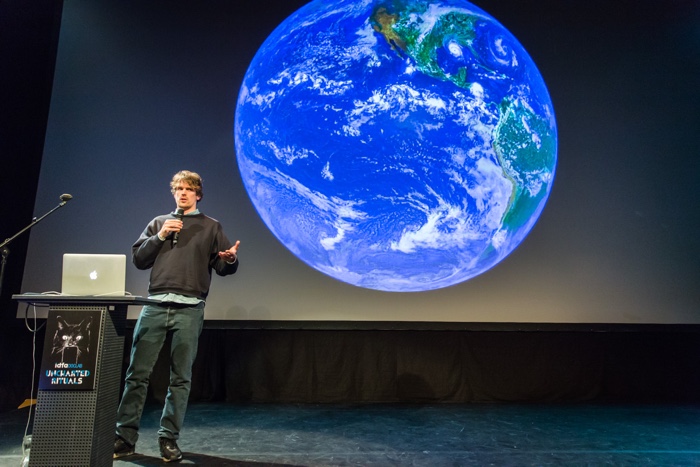
Jonathan Puckey at Doclab interactive conference in de Brakke Grond, part of the IDFA. Photo Nichon Glerum
Interactive designer Jonathan Puckey presented one of his ‘older’ projects and i adore it! The Radio Garden website allows you to spin a globe and listen to live radio from anywhere around the world.
He was actually on stage to present the interactive VR music video Dance Tonite which is rather impressive but i’m a fan of radio so i’ll stay with that good old media today.
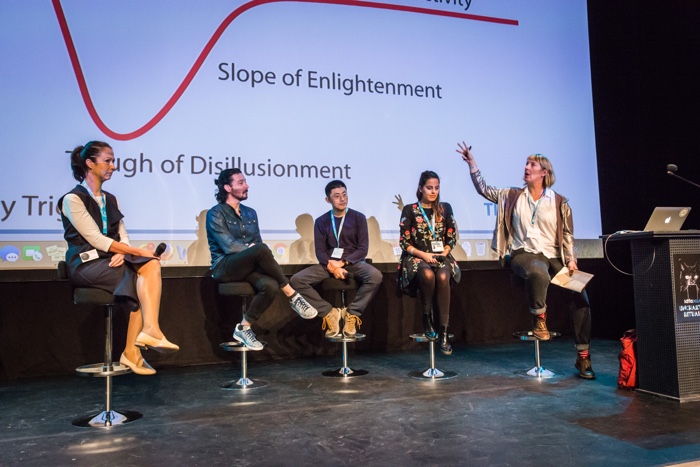
Panel with Francesca Panetta, the Guardian executive editor for VR, Oscar Raby, Creative Director at virtual Reality studio VRTOV, and filmmaker Zhao Qi
The panel with Francesca Panetta, the Guardian executive editor for VR, Oscar Raby, Creative Director at virtual Reality studio VRTOV, and filmmaker Zhao Qi managed to pack many ideas and reflections in 20 minutes or so. I learnt that:
– The Guardian has its own VR studio and they’ve made 8 VR pieces so far. They recently gave out 100 000 google cardboard goggles.
– Women in VR face much gender discrimination.
– There are some 5000 VR cinema and arcades in China, making it easier for VR creators to reach audiences.
– Research has shown that if someone reads an article, there is 1% chance that that person will look for more information about that topic. But there’s 25% chance if they experience that same topic via VR.
– In case you’re wondering about the graphic screened behind the panelists on the photo above, it’s the hype cycle which represents “the maturity, adoption and social application of specific technologies.”

Emilie Baltz at Doclab interactive conference in de Brakke Grond, part of the IDFA. Photo Nichon Glerum
Emilie Baltz creates musical licking performances and other food design extravaganzas. For DocLab, she collaborated with chef Matthias Van Der Nagel and Klasien V.D. Zandschulp to make us literally cook using a mobile phone, a box containing ingredients with strange textures and spiritual encouragement from Futurist Filippo Tommaso Marinetti. The result was called Amuse Telebouche.

The public enjoying Amuse Telebouche at Doclab interactive conference in de Brakke Grond, part of the IDFA. Photo Nichon Glerum
As you can see in this very flattering photo, I’m not too keen on experimenting with food:

Killjoy me refusing to taste Amuse Telebouche at Doclab interactive conference in de Brakke Grond, part of the IDFA. Photo Nichon Glerum

The public cooking Amuse Telebouche at Doclab interactive conference in de Brakke Grond, part of the IDFA. Photo Nichon Glerum

The public cooking Amuse Telebouche at Doclab interactive conference in de Brakke Grond, part of the IDFA. Photo Nichon Glerum
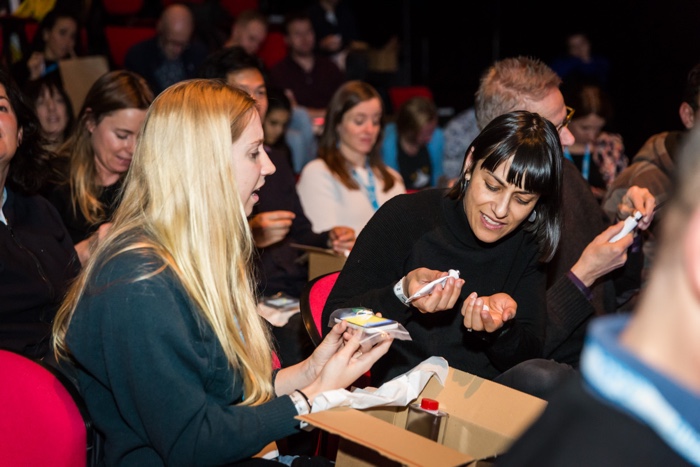
The public cooking Amuse Telebouche at Doclab interactive conference in de Brakke Grond, part of the IDFA. Photo Nichon Glerum

Jessica Brillhart and Jason Kottke at Doclab interactive conference in de Brakke Grond, part of the IDFA. Photo Nichon Glerum
Jessica Brillhart and Jason Kottke sat down on stage to ponder upon the question: The internet is on fire. What would you save? The selection included two of my favourite: Wikipedia and David OReilly’s Octocat.

Erwin Verbruggen at Doclab interactive conference in de Brakke Grond, part of the IDFA. Photo Nichon Glerum
Erwin Verbruggen from the Netherlands Institute for Sound and Vision presented FREEZE! A manifesto for safeguarding and preserving born-digital heritage.

W/O/R/K performance by Anagram at Doclab interactive conference in de Brakke Grond, part of the IDFA. Photo Nichon Glerum

W/O/R/K performance by Anagram at Doclab interactive conference in de Brakke Grond, part of the IDFA. Photo Nichon Glerum

W/O/R/K performance by Anagram at Doclab interactive conference in de Brakke Grond, part of the IDFA. Photo Nichon Glerum

Caspar Sonnen and the team of veryveryshort.com at Doclab interactive conference in de Brakke Grond, part of the IDFA. Photo Nichon Glerum
This event was part of the DocLab: Uncharted Rituals program, made possible by the Netherlands Film Fund, Mondriaan Fund, De Brakke Grond and Diversion.
Previously: DocLab exhibition asks “Are robots imitating us or are we imitating robots?”
Image on the homepage: Emilie Baltz.





![7 art and tech ideas I discovered at Meta.Morf 2024 – [up]Loaded Bodies 7 art and tech ideas I discovered at Meta.Morf 2024 – [up]Loaded Bodies](https://we-make-money-not-art.com/wp-content/uploads/2024/05/53705969154_73dfdfea6f_c-300x200.jpeg)

